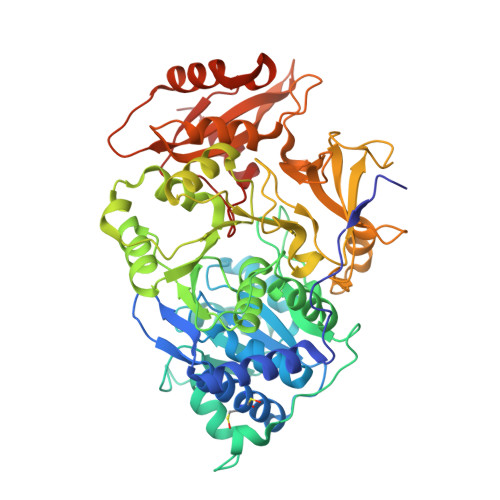Structural basis for the spectral difference in luciferase bioluminescence.
Nakatsu, T., Ichiyama, S., Hiratake, J., Saldanha, A., Kobashi, N., Sakata, K., Kato, H.(2006) Nature 440: 372-376
- PubMed: 16541080
- DOI: https://doi.org/10.1038/nature04542
- Primary Citation of Related Structures:
2D1Q, 2D1R, 2D1S, 2D1T - PubMed Abstract:
Fireflies communicate with each other by emitting yellow-green to yellow-orange brilliant light. The bioluminescence reaction, which uses luciferin, Mg-ATP and molecular oxygen to yield an electronically excited oxyluciferin species, is carried out by the enzyme luciferase. Visible light is emitted during relaxation of excited oxyluciferin to its ground state. The high quantum yield of the luciferin/luciferase reaction and the change in bioluminescence colour caused by subtle structural differences in luciferase have attracted much research interest. In fact, a single amino acid substitution in luciferase changes the emission colour from yellow-green to red. Although the crystal structure of luciferase from the North American firefly (Photinus pyralis) has been described, the detailed mechanism for the bioluminescence colour change is still unclear. Here we report the crystal structures of wild-type and red mutant (S286N) luciferases from the Japanese Genji-botaru (Luciola cruciata) in complex with a high-energy intermediate analogue, 5'-O-[N-(dehydroluciferyl)-sulfamoyl]adenosine (DLSA). Comparing these structures to those of the wild-type luciferase complexed with AMP plus oxyluciferin (products) reveals a significant conformational change in the wild-type enzyme but not in the red mutant. This conformational change involves movement of the hydrophobic side chain of Ile 288 towards the benzothiazole ring of DLSA. Our results indicate that the degree of molecular rigidity of the excited state of oxyluciferin, which is controlled by a transient movement of Ile 288, determines the colour of bioluminescence during the emission reaction.
Organizational Affiliation:
Kinetic Crystallography Research Team, Membrane Dynamics Research Group, RIKEN Harima Institute at SPring-8, 1-1-1 Kouto, Mikazuki-cho, Sayo-gun, Hyogo 679-5148, Japan.

















